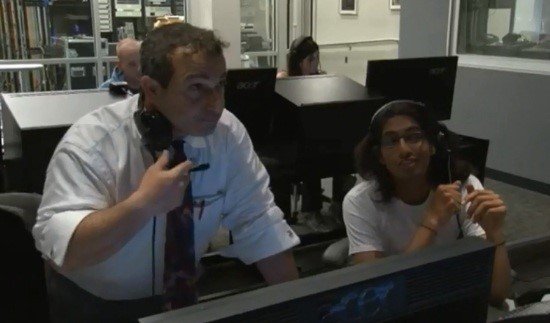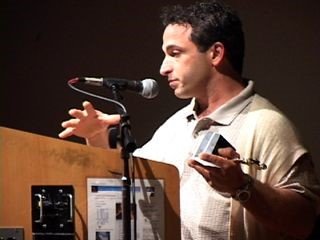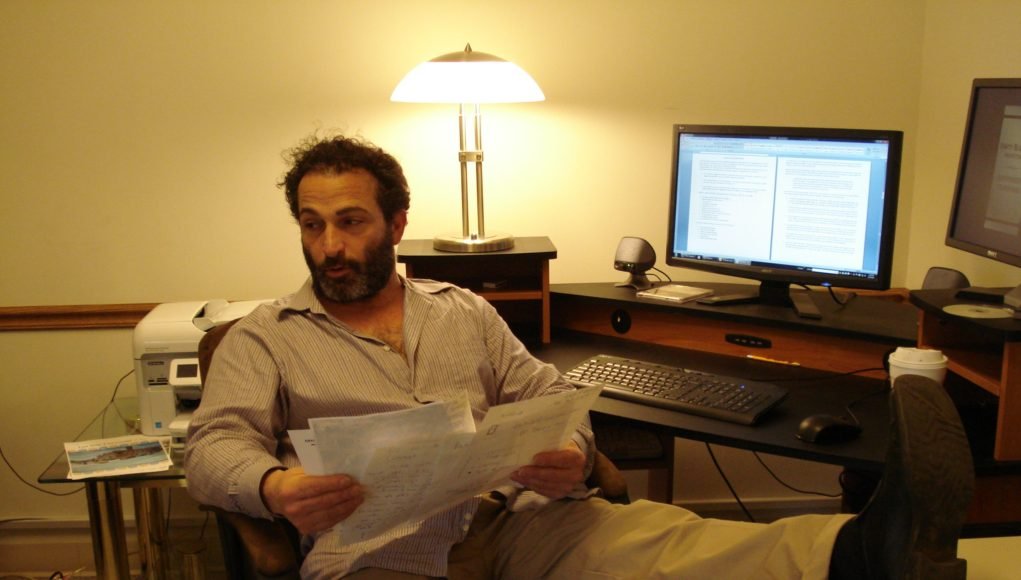Giovanni Sanseviero discusses the continuing journey of Face Painters
Giovanni Sanseviero, a native of Long Island, New York, is an actor, a filmmaker, a carpenter, a writer, an auteur, and a man with a relentless desire to share his creativity. His most recent screenplay, Face Painters, is a multi-generational saga with its main character on a life-changing journey. Face Painters has been well-received on the festival circuit, garnering nearly 70 awards as of publication.
Sanseviero took some time out of his schedule to discuss this screenplay along with the business of writing.
INFLUX: Face Painters is an ambitious screenplay, with events occurring in multiple locations and different time periods. What type of research did you do to maintain historical accuracy?
SANSEVIERO: I was curious to explore the unraveling of the American family, and research brought me to the late ‘50s when the nuclear family was about to change for good. This period was also trembling by the fast-approaching urban uprising via wealth and class inequities, and I would later use these social phenomena to demonstrate the polar opposites between the rivaling brothers of Gravetti and Sons Funeral Home. These two sociological issues became the canvas for everything within, and 1963, it was; as disruptive a year to pinpoint and put a jackhammer to.
Choosing 1928 for the earlier narrative was simple math, given my need to depict the family thirty-five years younger. This was especially important for Buono, the elder brother and our hero, where, as a six-year-old, an age when he could enlighten us with the musings of a mature thinker, could also be innocent enough, thinking he could catch a dolphin with macaroni. Although this 1928 narrative is multi-journey in itself, following the events of young Buono and his father, adult Buono is our narrator, reminiscing on what would later substantiate the struggles he endures as an adult. This was important; as of all the family members, his would be the most significant emotional bridge between these two oscillating eras.
The choice of 1963, for its historical events, only came after first understanding the differences between the two brothers. Buono was raised by compassionate parents, and his best childhood memories always provided him a safe haven fortified by the comfort of family roots and tradition. As a child, he also believed in helping people regardless of their background, so, as an adult, when he defends a black man from a racist Brooklyn neighborhood, 1963 proved the perfect year, with racial unrest at a boiling point, and providing a tense and effective backdrop almost effortlessly.
 Contrarily, the younger brother, Michael, experienced a childhood that didn’t include loving parents, so family tradition would prove unobtainable. He was raised by the modern colleges that his father callously resigned him to, and when the young man evolves into an imperious financial whiz kid, he at last finds an accepting family comprised of Wall Street greed, vanity, and racial bias.
Contrarily, the younger brother, Michael, experienced a childhood that didn’t include loving parents, so family tradition would prove unobtainable. He was raised by the modern colleges that his father callously resigned him to, and when the young man evolves into an imperious financial whiz kid, he at last finds an accepting family comprised of Wall Street greed, vanity, and racial bias.
And, exemplifying this business-above-all aggression would be his connection with the infamous soybean scandal of ’63, rocking the financial world and corporations for $180 million dollars ($1.52 billion today). This was apropos for Michael’s excess for money and success, and again, would prove an effective backdrop to explore.
1963 would also assist with the father’s character ark—the JFK assassination of November 22nd providing a significant date to apply to the earlier narrative when, on November 22nd, 1928, a life-changing event pummels the young man. This eventually evolves into the driving force behind his 1963 dementia-riddled story of love and redemption.
Even the 1963 intervals showing the Verrazzano Bridge, the longest suspension bridge in the US, nearing its completion, would provide profound book markers for another storyline’s crescendo. No matter which way I dug, 1963 kept proving gold.
INFLUX: Face Painters reads like a very personal story. Did you have a particular inspiration when conceiving and writing this? If so, we’d love to hear a little about this.
 SANSEVIERO: My parents were Italian-American immigrants that survived the hardships of Euro-fascism and war. And many times, as a kid, when I would scoff at the veggies on my dinner plate, I’d be flanked by their “during the war…” stories, making plain just how lucky I was to be able to poke fun at my food: that a scarce rabbit catch was really a cat smothered in sauce, and how a baker would mix marble dust into inferior dough just to give bread its familiar weight. For sure, when it came to old-school parents, subtleties would never be on the menu.
SANSEVIERO: My parents were Italian-American immigrants that survived the hardships of Euro-fascism and war. And many times, as a kid, when I would scoff at the veggies on my dinner plate, I’d be flanked by their “during the war…” stories, making plain just how lucky I was to be able to poke fun at my food: that a scarce rabbit catch was really a cat smothered in sauce, and how a baker would mix marble dust into inferior dough just to give bread its familiar weight. For sure, when it came to old-school parents, subtleties would never be on the menu.
The stories also included the hardships of immigrating to America; letting go of the traditions of families growing old together, generally in one region and benefiting from a family network, but then confronting the rude discoveries of a bustling, hard-hearted city like New York: the streets were not paved with yellow bricks, and there would be no magical wand to the fruits of the New World—certainly not evident while being spat on or being called a dirty immigrant.
It was these crushing stories of life’s realities that gave me an alternate view of the American dream, skewed somewhat, like a paradise flawed. And through the years, I found myself revisiting this alternate “dream theme” until it was clear that I had a story worth telling.
INFLUX: From conception to completion, how long did it take to write this screenplay, and can you share a bit about the process?
SANSEVIERO: I kept revisiting the story and knocking out drafts since 2002, but a couple of years prior was a half-baked stage play version which focused on a sibling rivalry.
Wanting more of a broader family story started with my first years as an actor. I was heavily influenced by stage plays and personally connected with family dramas the most… my parents were opera singers, so drama was just a way of life for me. Plays like Hat Full of Rain, True West, and Long Day’s Journey into the Night influenced me in the realm of family love tested; I Never Sang for My Father, in retrospect, had some similar parallels with Face Painters; a troubled son dealing with his old and withering father.
It wasn’t until 2016 when I put my acting on ice; for the next three years, I focused on sharpening Facer Painters until finally comfortable enough to go public and hit the festivals with. These were now the multigenerational versions with a double narrative structure in place and no longer just about the two brothers and many references to their father. Now, the earlier narrative in ‘28 would expound on the father’s turbulent story in Italy, his and his family’s journey to America, and eventually picking up in ’63 as the feeble funeral director of Gravetti and Sons Funeral Home.
INFLUX: This screenplay has received numerous awards and found great acclaim on the festival circuit. What are the challenges of getting this project to the next stage and into production?
SANSEVIERO: Ironically, the remaining present challenge, which I’ve pretty much given up on, was from the loftiest festivals themselves. Face Painters is antithetical in structure and page count, and bucks the tired Hollywood beat sheet. But after 159 competition entries and hitting sixty-eight awards, to date, I can say with some confidence that I have something that is working. Is it perfect? Hardly; cut some scenes? Certainly, cut it down to 120 pages as some of these bigwig competitions have suggested? Why, and would they even be reading the same story?
 I think these types of competitions are wrongly serving the status quo, guru three act for their own advantages, and totally contradicting their mission statements, heralding, “a screenplay competition dedicated to discovering and nurturing emerging screenwriter,” or, “an international screenwriting competition established to identify and encourage talented new screenwriters.” Sure, but other than a Metropolis factory worker need not apply. This is what I experienced, being told flat-out that too many pages is a sure sign of a greenhorn screenplay, and that I must learn to kill my darlings — extraordinarily presumptuous advice when considering they hadn’t even read the title yet, and my intension for the last five years WAS to write an epic.
I think these types of competitions are wrongly serving the status quo, guru three act for their own advantages, and totally contradicting their mission statements, heralding, “a screenplay competition dedicated to discovering and nurturing emerging screenwriter,” or, “an international screenwriting competition established to identify and encourage talented new screenwriters.” Sure, but other than a Metropolis factory worker need not apply. This is what I experienced, being told flat-out that too many pages is a sure sign of a greenhorn screenplay, and that I must learn to kill my darlings — extraordinarily presumptuous advice when considering they hadn’t even read the title yet, and my intension for the last five years WAS to write an epic.
If all this sounds like I’m bitter, you may be onto something, but I’m not bitter because I entered and wasn’t accepted; I’m bitter because I wasn’t even allowed to enter and presumably because I didn’t know what I was doing … (deep breath) … but onward and upward till the goal ye win!
I need to find one of these social media managers that have a head start in the entertainment arena; I’m why behind as for spreading the news in a more worldwide manner. Representation would also be an enormous help, so I’ll research this, too. This one should be enlightening, like doing cartwheels in a cow meadow of familiar advice.
I will also be gearing up to approach the actors I have in mind for my little story. I don’t see riding a coattail or two hurting while producers are eventually sought. I’m very confident these actors will appreciate their multilayered characters, offered within a vast playground to scrutinize and discover; I really need to now go where my work will be appreciated, so, as for now and what comes later, actors read words, producers count pages.
INFLUX: In a dream-come-true scenario, if a studio gave this project an unlimited budget, a director of your choice, and your pick of actors, would you be willing to share a bit about how you’d like to see it done?
SANSEVIERO: Well, if I were dreaming to the nth power, I’d ask the likes of a Milos Forman or a Sergio Leone to take the helm—no explanation needed here. But, as for a plausible come-true scenario? Mark Ruffalo (twice suggested to me) to play Buono, the elder, illiterate son (1963), and the character Face Painters completely revolves around (no idea who would portray Buono as a child, but think loveable Toto from Cinema Paradiso); Bobby Cannavale to play Luca, the overreaching father (1928) and failing elder (1963), the deuteragonist in our story and, no lie, suggested to me on four different, unsolicited, occasions; Vincent Piazza to play Michael, the younger turbulent brother (1963); Stanley Tucci to take on Leo, the hard-nosed patriarch (1928); Benicio Del Toro to cameo Garibaldi, a poetic shipping mogul (1928); Mark Margolis to play Fatman Providenza, a callous local strongarm (1928); Marion Cotillard to play Isabella, Buono’s loving and unwavering mother (1928); Shiri Appleby to portray Abbey, Buono’s love-torn companion (1963). Not sure who would portray feisty Scarlett, her tomboy daughter, but think Scout from To Kill a Mockingbird; John Amos to play Freddie, a downtrodden father (1963); Jon Hamm to play Elias, a suave Wall Street investor (1963); Juliette Lewis to play drunkard Molly, Michael’s “Teddy Girl” squeeze (1963), and Bill Camp to take on Bishop Pio, a trickster cleric (1928).
As for directing, a few names obviously come to mind, and an actor’s director would be paramount. I don’t know why, but over the past few years, and as unusual as Daniel Day-Lewis may seem for a director’s choice, I keep thinking … why not? What he represents as a disciple and practitioner of cinematic storytelling, in general, tops my list as a person possessing the consummate sensibilities for a sweeping epic like Face Painters.
Visit www.facepainters.net to learn more.






